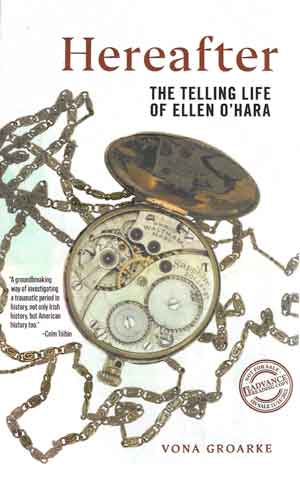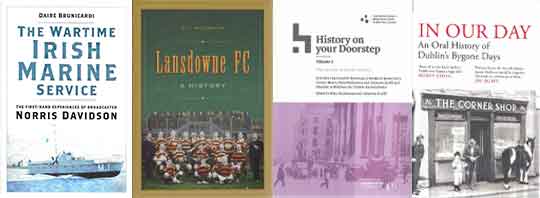BOOKWORM
Published in Book Reviews, Book Reviews, Issue 2 (March/April 2023), Volume 31By Joe Culley
@TheRealCulls
It’s a familiar story, almost a cliché: in the 1880s a young woman from a large family leaves the struggling farm in Sligo to emigrate to New York. There she finds work as a domestic servant, a ‘Biddy’, dutifully sends home remittances, makes an unhappy marriage, has children, and through hard work and perseverance over decades comes to own and manage a boarding-house in New York’s Upper East Side. But there is absolutely nothing clichéd about Hereafter: the telling life of Ellen O’Hara, Vona Groarke’s absorbing, magical ‘imagining’ of her great-grandmother’s life.
You may be familiar with Groarke’s work as a poet. In Hereafter she brings that sensibility to the process of writing biography, for in Ellen’s case the actual hard, diamond-edged facts of her story are thin on the ground. Standard research in the archives offers little, so Groarke is forced to approach on a different tack. She comes to know Ellen through imagined interrogation, through conversations exchanged in sonnet form, in fiction, in reminiscence.
Yes, that sounds like it should be nonsense, but this is all beautifully interwoven with solid historical research and, importantly, the story the family told itself. By the end we know Ellen well; we feel we know why she brought her young children back to her parents’ home and ‘abandoned’ them for a decade, and why, in the end, she was abandoned.
And by this innovative, careful examination of the cliché and the formal archives Groarke helps to recover the parallel lives of countless other women. In the end, she even proposes that ‘the link … between the work of Irish women abroad and the foundation of the Irish state is clear and strong (if largely unacknowledged)’.
And just wait until you discover why there are no letters.
Although he would be little remembered today, Norris Davidson was a noted screenwriter and documentary producer with RTÉ in the 1950s, ’60s and ’70s. The son of a barrister originally from the North of Ireland, James Norris Goddard Davidson—to give him his full name—was born in 1908 in Dublin into a wealthy family (one of their residences is now Sutton Park School). And, although he was educated at Portora Royal School, Enniskillen, and Cambridge University—where he won a ‘blue’ for the rowing team—he fully identified as Irish (just like his Portora contemporary Samuel Beckett).
So, when the Second World War came—indeed, even before it had begun, as he spent the summer of 1939 on Inis Mór ruminating—he had resolved to serve not in the RAF or the Royal Navy, as one might expect, but with the nascent Irish marine service. The wartime Irish marine service: the first-hand experiences of broadcaster Norris Davidson is his previously unpublished manuscript ‘Various Courses’, recalling his time there. It is part diary, i.e. written at the time, and part reminiscence, written just after the war.
Not surprisingly, given his education and background—he counted among his friends Harry Kernoff, Liam O’Flaherty and Evie Hone—it is extremely well written. It is full of entertaining insights, first into life on coastal watch on Bray Head, where he spent the first year, and then of life aboard the patrol vessel Muirchú for most of the ‘Emergency’. Davidson is good company, often humorous, and, it must be emphasised, exceptionally dedicated to the service and his colleagues in it. He is scathing about how it was treated at the end of the war and, essentially, broken up.
Before his death, Davidson entrusted the manuscript to ex-naval officer Daire Brunicardi, who has written a foreword to set the scene, as well as providing some fascinating photos and wartime ephemera. It is a fine read about a sorely neglected aspect of our wartime experience.
The committee at Lansdowne (rugby) Football Club have been well rewarded by their decision to employ a professional historian and writer to mark the club’s 150th anniversary in 2022. UCD lecturer Charles Ivar McGrath, whose usual focus is on seventeenth- and eighteenth-century Ireland, regularly places the story of Lansdowne FC: a history firmly within the events of the day and the society in which the club members lived.
For example, most will be familiar with the ‘pals’ brigades of the First World War. Well, in August 1914 the IRFU established a volunteer corps of members to serve in the British army, a body that eventually became D Company of the Royal Dublin Fusiliers. Tragically for them, they were destined for Suvla Bay: of the 239 ‘pals’ who landed there exactly a year later, by the end of September only 79 had survived. Among the dead were 22 associated with Lansdowne FC. By war’s end some 75 current or past members had been killed.
Of course, Lansdowne is one of the oldest clubs in Ireland. It was the brainchild of H.W.D. Dunlop and was founded before the establishment of the IRFU. Any number of Ireland’s great internationals played for the club—J.J. Coffey, Jack Arigho, Ned Lightfoot, Con Murphy, Moss Keane, Mick Quinn, Dick and Donal Spring, Michael Kiernan and Eric Elwood. One of its distinctions is that it was never associated with a particular school and thus has a tradition of being the club for players coming from outside Dublin.
McGrath also tackles the question of the effect that modern professionalism—and the emergence of the Leinster Academy—has had on the club. This handsome production may have limited appeal to the general reader, but anyone interested in the history of the game here will be engaged.
Since 2017, Dublin City Council’s ‘Historians in Residence’ project has been producing a series of slim collections of essays designed to focus on particular neighbourhoods, to encourage the locals to engage with history and to promote the collections in Dublin City Library and Archive. Now, volume five of History on your doorstep: Five stories of Dublin history has arrived, and this is our first time to engage with the project.
This edition, appropriately, focuses on events around the Civil War. The essays address ‘An ash shower mistaken for snowfall caused by burning pyres of paper files at Dublin Castle; the painting of pillar-boxes from red to green across the capital; an attack in a small hamlet called Red Cow on the Naas Road; and the transformation of market gardens and allotments into the Irish Free State’s first public housing scheme, The Tenters in Dublin 8’.
Other volumes in the series explore the legacy of architect Herbert Sims, why Lemon Street is called Lemon Street, and the life of football player and manager extraordinaire Patrick O’Connell, who played for Manchester United and went on to manage FC Barcelona.
The city’s Historians in Residence are James Curry, Cormac Moore, Mary Muldowney, Catherine Scuffil and Dervilia Roche. Each book is freely available in your library, or as an eBook from dublin.borrowbox.com and to download as a PDF at https://www.dublincity.ie/library/blog/history-your-doorstep-your-fingertips.
On that theme, it’s fair to say that Dublin has been well served by its historians. Among the most prolific is veteran (he’ll be 83 this year) Kevin C. Kearns, whose In our day: an oral history of Dublin’s bygone days is the culmination of his 50 years of walking the streets trying to capture ‘the small piece of history’ that is in all of us. There are 450 ‘vignettes’ in the collection. I’m certain that some clever theatre/radio producer could build a terrific audio presentation from the contents, but at least these voices won’t be lost, and for that we can be thankful.
Vona Groarke, Hereafter: the telling life of Ellen O’Hara (New York University Press, $22.95 hb, 176pp, ISBN 9781479817511).
Daire Brunicardi, The wartime Irish marine service: the first-hand experiences of broadcaster Norris Davidson (The History Press, £17.99 pb, 162pp, ISBN 9781803991726).
C.I. McGrath, Lansdowne FC: a history (Open Air, €40.50 hb, 320pp, ISBN 9781801510547).
James Curry, Cormac Moore, Mary Muldowney, Catherine Scuffil and Dervilia Roche, History on your doorstep, Volume 5: Five stories of Dublin history (Dublin City Council, available in libraries and on-line, 76pp, ISBN 9781838463564).
Kevin C. Kearns, In our day: an oral history of Dublin’s bygone days (Gill Books, €24.99 hb, 272pp, ISBN 9780717195596).


















